2011 Skelly Family Christmas |
|
 |
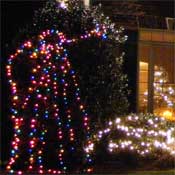 |
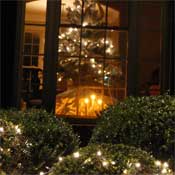 |
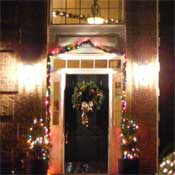 |
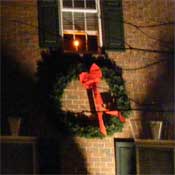 |
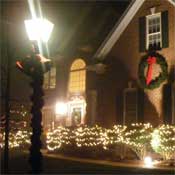 |
| Christmas Weblog | Christmas Past | Christmas Present | Christmas Yet to Come |
| Christmas '10 |
| Christmas '09 |
| Christmas '08 |
| Christmas '07 |
| Christmas '06 |
| Christmas '05 |
| Christmas '04 |
| Christmas '03 |
| Christmas '02 |
| Christmas '01 |
| Christmas '00 |
| Christmas '99 |
|
Roll Out the Holly!
This is not just about a little evergreen strewn casually about the house, not even the lovely woven braid that will be the prettiest sight you'll see ‘round your own front door.
This is about more than some jolly wreath with red satin ribbons that tail down to your kids’ knees. It’s about more than candles placed in in all the front windows or an insensate wire-frame deer posed on your front lawn, nodding its head silently up and down at passing cars. 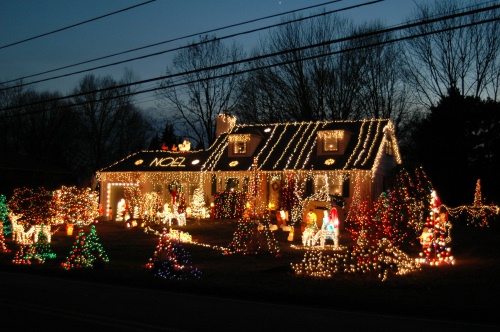
What we’re talking about here is serious, committed, big-time holiday display. Lights: thousands of them, running up every corner of your abode, along the soffits, outlining the dormers and tracing the whole roofline. Winking and blinking and flashing and strobing, jamming the pacemakers of old people who happen to pass by. Wired into sub-circuits and surge protectors, silhouetting every bush and tree on your property and setting your electric meter to spinning madly. We’re talking about action: two-story Santas waving motor-driven mechanical arms, and Frosty characters taller than the Stay-Puft Marshmallow Man in Ghostbusters II. We’re talking about out-of-control ostentation, traffic-stopping, community-disrupting productions that land on the evening news at least once a holiday season and bring the police out several times. We’re talking Christmas Spirit writ grotesquely large, with stereo sound systems and huge sub-woofers throbbing holiday carols deep into the night. And when you turn it all on, it draws so much power it dims all the lights in the other parts of town. What we're talking about is scale: something that could have been produced by Clark Griswold’s evil twin and shoved right up your next-door neighbor’s, er, face. Ever get that way? Some folks do. Decorating for holidays is an old custom, pre-dating Christmas. In the sixth century BC the prophet Jeremiah condemned the pagan practice of cutting down trees and bringing them into the home to decorate (oh, and worship). 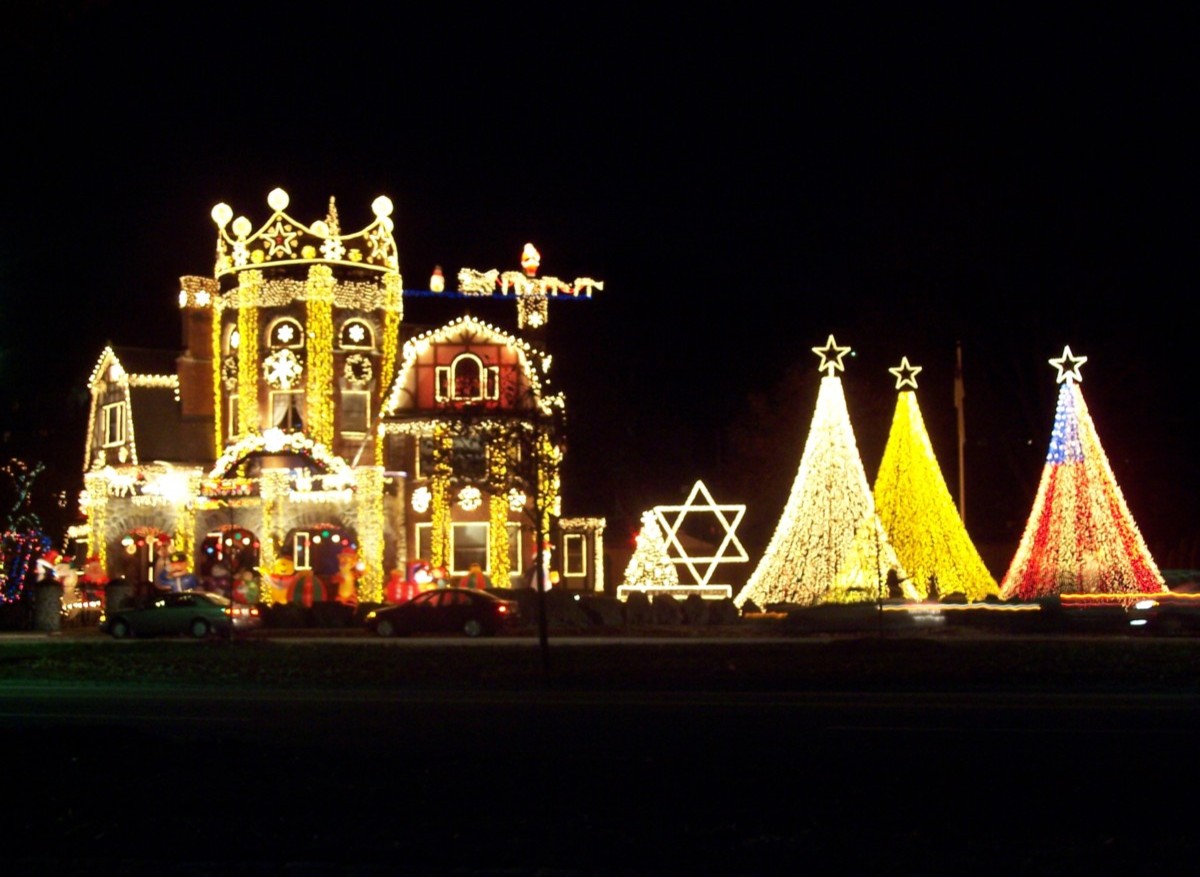
Lights came much later. It’s Thomas Edison we have to thank for that. Naturally. Edison is revered as an inventor who refused to curse the darkness, but in reality he was a businessman who saw profit everywhere he looked. If he were alive today, he’d be lobbying Congress for tax breaks and special treatment. He founded GE, for the love of God, the company that came within a whisker of making the Hudson River glow in the dark. An Edison assistant, Edward Johnson, came up with electric lights for Christmas trees in 1882. Mass production began in 1890. San Diego in 1904, Appleton, WI, in 1909, and New York City in 1912 were the first cities to decorate with Christmas lights outside. As the twentieth century progressed, Christmas lights did, too. People started using strings of lights to adorn mantles and doorways. Eventually regular folks began to display them outside as well, along rafters, roof lines, and porch railings of both homes and businesses. Edison was pleased. To spur sales, General Electric started sponsoring community lighting competitions in the 1920s, By the mid 1950s the lighting tradition had spread to to a broad swath of households, and the real competition began in earnest. |

Today Christmas lights come in a dazzling array of configurations and colors. The technology exends from simple light strands to full-blown animated tableaux involving complex illuminated animatronics and statues. Common lamp types include incandescents, light-emitting diodes (LEDs, which are energy efficient) and even neon lamp sets. Fluorescent lamp sets were produced briefly by Sylvania in the mid-1940s.
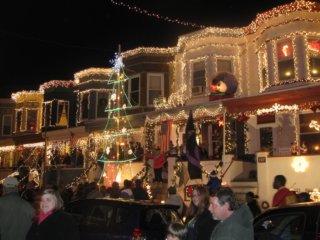 According to a study by Unity Marketing of Stevens, PA, spending on new holiday decorations reached $15.8 billion in 2005, and the Christmas season accounted for over half the market. According to a study by Unity Marketing of Stevens, PA, spending on new holiday decorations reached $15.8 billion in 2005, and the Christmas season accounted for over half the market.
In 2005 sales of outdoor holiday decorations reached $3.8 billion, up 15% from the previous year, compared to 5.3% growth in indoor decoration spending. The three biggest categories for outdoor decorating were flowers, plants and wreaths; outdoor lights and lighted sculptures; and flags, banners and signs. Outdoor inflatable balloons were the fastest growing category. Holiday decorating has advanced to the point that it has spawned a Christmas Decor franchise industry to handle the chore for homeowners looking for help or expanded capabilies. Typical decorating prices range from $1,200 to $1,800 per house. Feel like too much? Consider this: According to the Centers for Disease Control and Prevention, on average about 5,800 people visit the emergency room for fall-related injuries sustained while decorating during the holiday season. Turning all those decorations on costs more money. Most households can expect a $10 to $20 increase in their monthly electric bill. Rates vary geographically. And, of course, do more, pay more. A lavish display could, depending on where you are, bump up your monthly bill by $100 or more. (Here's a handy calculator.) 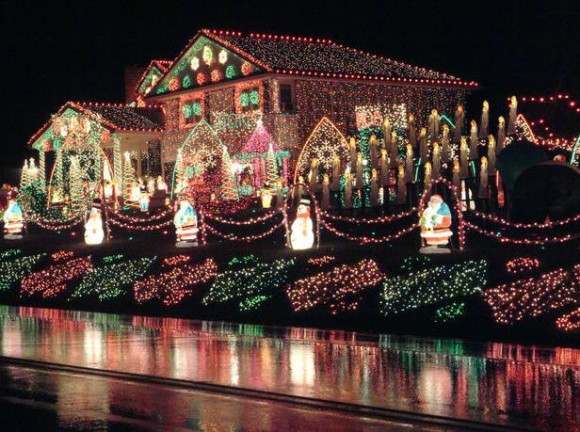
This Christmas display in Delaware contains 1,000,000 lights and is said to have cost $686/hour, or $82,320 a month, to operate. A few years back, a video of a Christmas sight-and-sound extravaganza at the Carson Williams home in Mason, OH, went viral on YouTube. It has been viewed more than 9 million times. Williams eventually turned his hobby into a commercial venture. To see, and hear, his handiwork, click here. Watch a whole bunch of copycat holiday decoration videos, too, while you're there. You'll save on gas that way. |
Go to websitesammy.com homepage
Christmas Light Animation provided by MySpaceAnimations.com